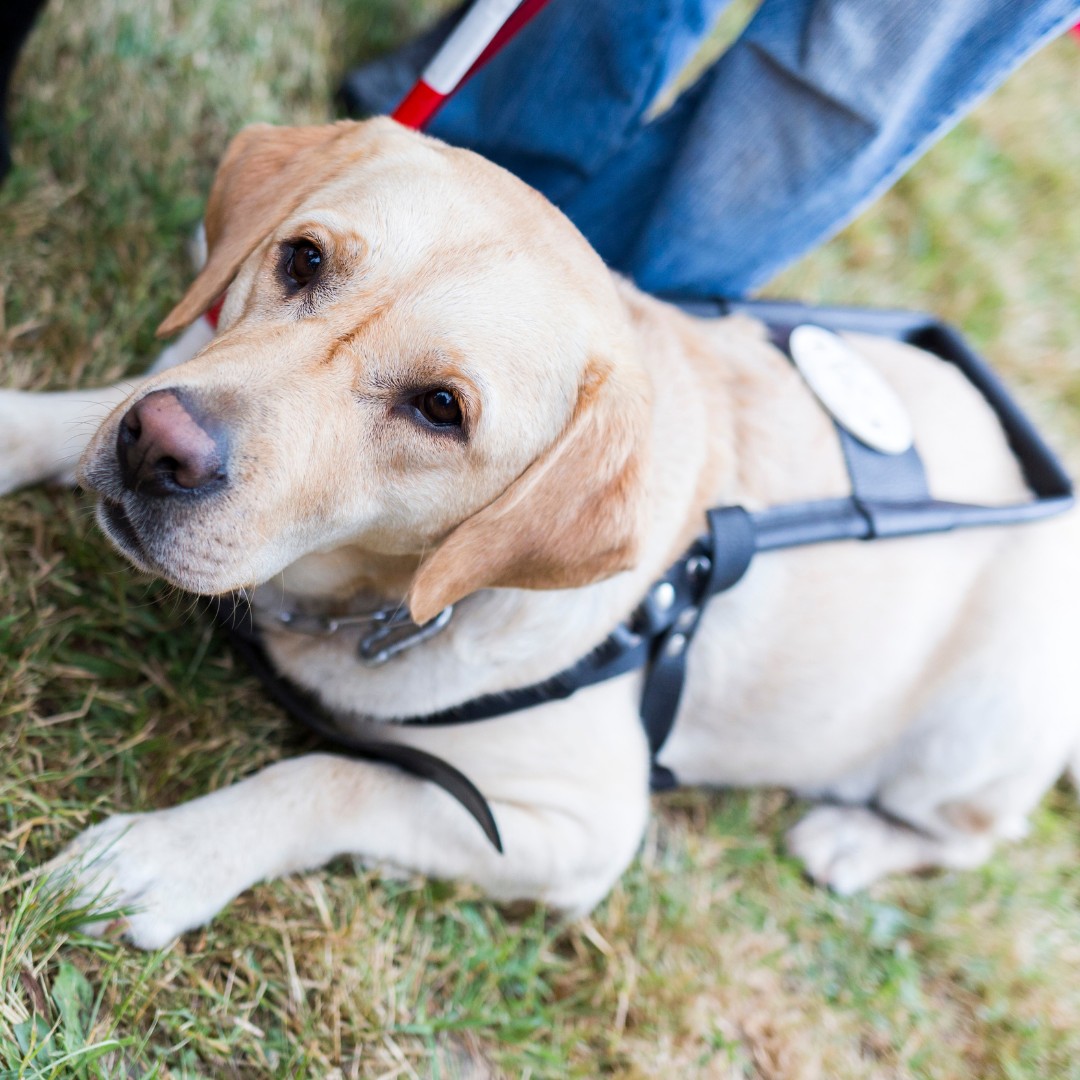Guide dogs provide invaluable assistance to individuals who are blind or visually impaired, acting as their eyes and enabling them to navigate the world with increased confidence and independence. These remarkable animals undergo rigorous training to master the skills necessary to guide their handlers safely. A common question is: What Age Do Guide Dogs Start Training? This article delves into the typical timeline for guide dog training, exploring the various stages from puppyhood to becoming a fully qualified guide.
 Golden Retriever guide dog laying on the ground looking at the camera, symbolizing the intelligence and calm demeanor required for guide dog work.
Golden Retriever guide dog laying on the ground looking at the camera, symbolizing the intelligence and calm demeanor required for guide dog work.
Puppyhood: The Foundation (8-10 Weeks)
Most guide dog organizations have dedicated breeding programs, carefully selecting dogs for desirable traits such as intelligence, temperament, and trainability. Puppies are typically born and raised in a nurturing environment on the training school’s campus. At approximately 8 to 10 weeks of age, these young pups embark on the first crucial stage of their journey: socialization.
During this period, puppies are placed with volunteer “puppy raisers.” These dedicated individuals welcome the puppies into their homes and expose them to a wide array of experiences, including:
- Basic Obedience: Learning commands like “sit,” “stay,” “come,” and “down.”
- Socialization: Interacting with diverse people, animals, and environments, such as crowded streets, public transportation, and various indoor settings.
- Manners: Developing appropriate behavior in public, such as refraining from jumping, barking excessively, or begging for food.
This early socialization is vital for building the puppy’s confidence, adaptability, and overall temperament, laying a solid groundwork for future guide dog training. Puppy raisers play a key role in helping the dogs get used to different sights, sounds, and smells that they will encounter as working dogs.
Formal Training: The Core Curriculum (14-18 Months)
At around 14 to 18 months old, the puppies return to the guide dog school to begin their formal training. This intensive program typically lasts several months and focuses on teaching the dogs the specific skills required to guide a visually impaired person safely. This is when the real answer to “what age do guide dogs start training” becomes apparent. The formal training curriculum often includes:
- Advanced Obedience: Refining obedience skills and introducing more complex commands.
- Navigation Skills: Learning to navigate obstacles, such as sidewalks, curbs, stairs, and doorways.
- Traffic Training: Understanding traffic patterns and responding to commands related to crossing streets safely.
- Intelligent Disobedience: This critical skill teaches the dog to disobey a command if it would put the handler in danger. For example, a dog will refuse to walk into oncoming traffic, even if instructed to do so.
- Problem Solving: Learning to adapt to unexpected situations and find solutions to navigate challenges.
Matching and Team Training: The Final Step
After completing their formal training, the dogs are carefully matched with a potential handler based on factors such as personality, lifestyle, and walking speed. The student and dog then train together for a period of 2 to 4 weeks under the guidance of experienced instructors. This team training helps the pair develop trust, communication, and a strong working relationship.
During this phase, the handler learns how to:
- Give commands effectively.
- Interpret the dog’s signals.
- Maintain a consistent and supportive partnership.
Alternative Training Paths
While most guide dog schools follow the traditional puppy raising model, some individuals choose to train their own guide dogs. This can involve starting with a puppy or rescuing an older dog. Training a guide dog independently requires significant time, dedication, and expertise, but it can be a rewarding experience for both the handler and the dog.
Ongoing Training and Support
Even after graduation, guide dog teams benefit from ongoing support and training from the guide dog school. This ensures that the team maintains their skills and addresses any challenges that may arise. Regular follow-up visits and refresher courses are often provided to support the long-term success of the partnership.
Retirement
Guide dogs typically work for 7-10 years before retiring. After retirement, they may be adopted by their handler, a family member, or a close friend. They deserve a comfortable and loving home where they can enjoy their golden years.
Conclusion
So, what age do guide dogs start training? The journey of a guide dog begins in puppyhood with socialization and basic obedience, followed by formal training at around 14-18 months. This rigorous process prepares these exceptional animals to provide invaluable assistance to individuals who are blind or visually impaired, empowering them to live more independent and fulfilling lives. The dedication of breeders, puppy raisers, trainers, and handlers, all contribute to the success of these remarkable partnerships.